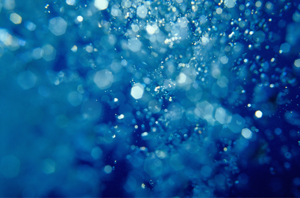Jun. 27, 2014 Research Highlight Chemistry
Solving the salty problem of protein stability
Advanced spectroscopy of molecular interactions helps resolve the century-old mystery of how aqueous ions affect proteins in solution
 Figure 1: Ultrafast laser experiments reveal that hydrogen bonding interactions between water molecules surrounding biomolecules help determine the stability of biomolecules in salt solutions. © Ryan McVay/Photodisc/ Thinkstock
Figure 1: Ultrafast laser experiments reveal that hydrogen bonding interactions between water molecules surrounding biomolecules help determine the stability of biomolecules in salt solutions. © Ryan McVay/Photodisc/ Thinkstock
In the late 1800s, Czech chemist Franz Hofmeister discovered that the relative ability of ions to either dissolve or precipitate proteins in water followed a curious order. Instead of obeying accepted chemical principles, this sequence seemed to occur almost arbitrarily. Although researchers have successfully exploited the ‘Hofmeister series’ to develop stable, biomolecular-based pharmaceuticals, confusion over the microscopic mechanisms behind this phenomenon prevents accurate prediction of how novel pharmaceutical molecules might affect protein aggregation in water.
In research that could help explain the inscrutable ordering patterns of the Hofmeister series, Tahei Tahara and colleagues from the Molecular Spectroscopy Laboratory at RIKEN have now resolved the molecular structure of water around ions in charged solutions1.
The Hofmeister series is difficult to understand because ions can influence both water and proteins in complex ways. For example, since the surface tension of pure salt solutions follows Hofmeister series ordering, scientists long believed that ion-induced changes to bulk water were responsible for ‘salting’ proteins in or out of solution. However, this theory fails to match thermodynamic evidence, and researchers are now investigating the role of direct interactions between macromolecules and aqueous ions.
Tahara and his colleagues reasoned that Hofmeister series ordering could be clarified through precise measurements of water molecules participating in macromolecule–ion interactions. Signals from water involved in such interactions are difficult to quantify because they are obscured by the much larger signals from bulk water. Fortunately, the team has spearheaded development of a technique called heterodyne-detected vibrational sum frequency generation (HD-VSFG) that is able to detect the infinitesimal vibrational signals of interfacial water through their nonlinear response to ultrashort laser bursts.
The researchers studied water structures at the interfaces of cetyltrimethylammonium (CTA+) and dodecyl sulfate (DS–) surfactants—two oppositely charged model materials that obey the Hofmeister series. By comparing the HD-VSFG signals of the pure surfactants to those containing ionic salts, they identified multiple mechanisms at play in this system. For the positively charged CTA+ surfactant, the Hofmeister ordering is related to the ability of anions to displace water at the interface. For cations associated with the negatively charged DS– interfaces, however, the order correlates with changes in the hydrogen-bond strength of interfacial water—a fundamental discovery made possible only through use of the ultrasensitive HD-VSFG technique.
“This work provides molecular-level views of interactions between proteins and ions, as well as water–protein interactions,” says Tahara. “It provides an important basis for research into biomimetic polymers suitable for medical use.”
References
- 1. Nihonyanagi, S., Yamaguchi, S. & Tahara, T. Counterion effect on interfacial water at charged interfaces and its relevance to the Hofmeister series. Journal of the American Chemical Society 136, 6155–6158 (2014). doi: 10.1021/ja412952y
